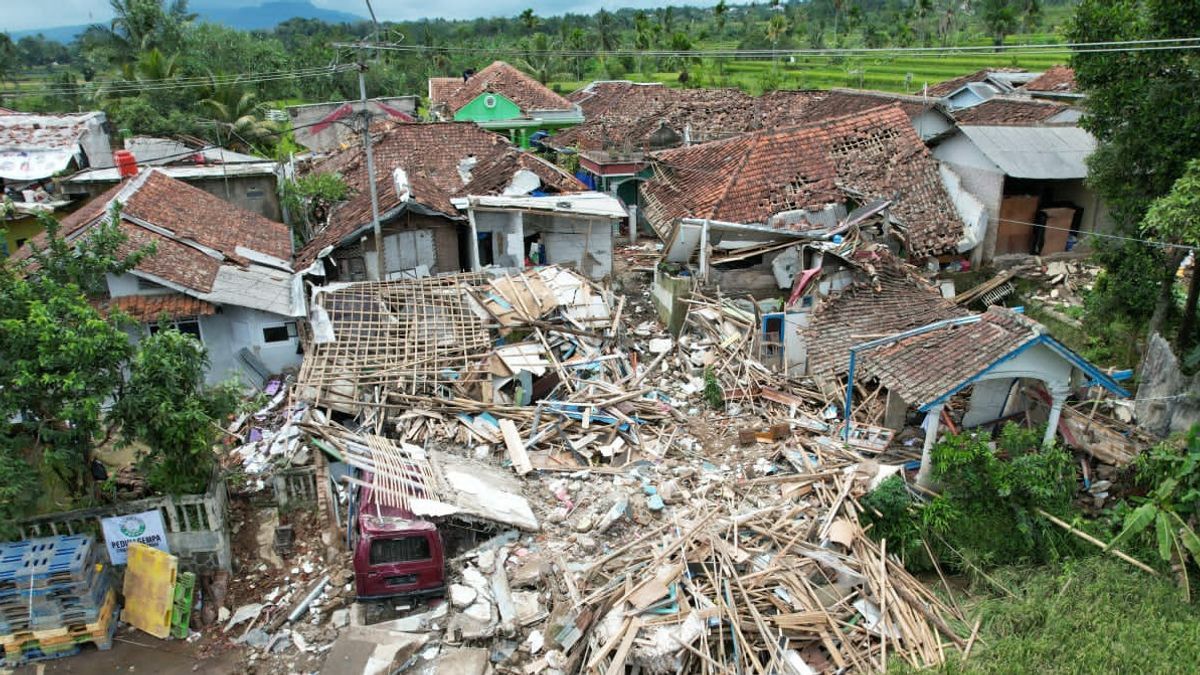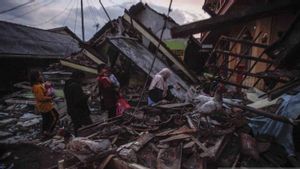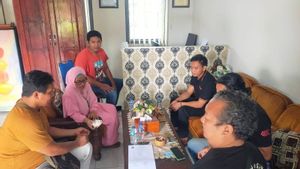JAKARTA - Indonesia is geographically located in the Pacific Ring of Fire region. The meeting place of three world tectonic plates such as the Indo-Australian Plate, the Eurasian Plate, and the Pacific Plate. These plates are constantly moving in different directions in very slow motions that cannot be seen by the eye. Can move away from each other, collide with each other, or slide each other sideways.
Scientists, as written in the book 'Merancang Rumah di Area Gempa' (Designing a House in an Earthquake Area) suspect that plate movement occurs due to the transfer of geothermal heat through liquid or gas. The principle is the same as water which continues to stir as long as it is heated.
The movement of the plates is what often causes earthquakes. The larger mass of the oceanic plate will sink down when it collides with the continental plate in the collision (subduction) zone. Its movement will experience a slowdown due to friction from the earth's envelope which further causes a buildup of energy in subduction zones and fault zones. As a result, pressure, pull and shear occur in these zones.
"When the plate elasticity limit is exceeded, rock fractures occur, followed by a sudden release of energy. This process causes particle vibrations in all directions which are known as earthquake waves,” wrote the book by Esmeralda Contessa, Ph.D; Ir. Dudy Priyatna; Haris Munandar, M.A.

The Eurasian and Indo-Australian plates collided with each other off the west coast of Sumatra Island in the southern part of Java Island, off the South coast of the Nusa Tenggara islands, then turned northward into the waters of the southern Moluccas, close to Papua.
In fact, there is also a collision between the Indo-Australian and Pacific plates around the island of New Guinea. The meeting between the three plates occurred around Sulawesi.
This means that earthquakes, even tsunamis have become unavoidable. Chairman of the Association of Indonesian Disaster Experts (IABI) Dr. Ir. Harkunti P. Rahayu in an interview with VOI some time ago suggested that people inevitably have to live in peace with earthquakes.
“Yes, that's what happened. Remember that an earthquake will not kill, what kills is a building that is above ground level. People can be crushed or crushed by buildings, that's what makes them die," Harkunti said, as reported by VOI.
That is why, one sure way is to require earthquake-resistant building safety design rules, especially for buildings that are on or around fault lines. Thus, if an earthquake occurs, the number of victims can be minimized.
Earthquake Resistant Buildings
Houses are usually only built by paying attention to the bearing capacity of the vertical force so that it can withstand the force of gravity. Rarely is a house calculated to have resistance to horizontal forces.
Thus, when an earthquake occurs, the building easily collapses. See the impact of the Cianjur earthquake on November 21. The National Disaster Management Agency (BNPB) said that 62,628 houses were damaged, including 27,434 houses that were heavily damaged, 13,070 houses that were moderately damaged, and 22,124 houses that were slightly damaged. The earthquake also damaged 398 schools, 160 places of worship, 14 health facilities, and 16 office buildings.
"In order for this to be avoided, all parts of the building structure starting from the foundation, floor, pillars, walls, to the roof must fit together properly," wrote Esmeralda Contessa, Ph.D et all still in the book "Merancang Rumah di Area Gempa’".
To determine how strong a house must be designed and built to withstand earthquakes, there are several things that must be known first. First, is the condition of the soil, whether it is classified as soft so that an earthquake will increase the shaking, or is the soil hard so that it is stable and the risk of damage from an earthquake is estimated to be smaller.

The condition of the soil in the location we chose can be known from the map made by the Center for Volcanology and Ecological Hazard Mitigation," said Esmeralda.
Second, the condition of the building. Based on experience there are several building design conditions that should be avoided because they are very vulnerable to earthquakes, namely:
- Buildings that are too tall, too wide, or too long. Buildings that are too high without adequate reinforcement will not be able to withstand the horizontal thrust of the earthquake. Likewise with buildings that are too long and too wide.
- The buildings that were the strongest against earthquakes were those with simple geometric shapes. Buildings that have many angles are very dangerous during an earthquake.
“If the building as a whole must be maintained in shape, for example, due to the shape of the land owned, security measures can be taken, among others, by separating the building into several units, each of which has a simple geometric shape. Like an equilateral quadrangle or a quadrilateral with a ratio of length and width that is not too different," continued Esmeralda.
- Buildings with a certain design. For example, a building with different floor heights, varying floor widths, or part of the floor being used as an open atrium without pillars. It is interesting in design, but dangerous when an earthquake occurs.
There is no function of channeling inertial forces to the ground quickly and adequately so that if an earthquake occurs, the building will suffer severe damage and of course endanger the people who are in or around it.
- There must be a separation distance between buildings, especially if the building is tall. The suggested geometric shapes tend to be simple and equal-sided. This is based on the observation that there is a twisting force on the building caused by earthquake shocks.

Next, the wall design. There are several instructions for making walls strong and able to withstand earthquakes:
- Connections between walls must be made interlocking. For houses, there are usually four types of ties that are installed horizontally to strengthen the unity of the building structure, namely sloof beams on the foundation, tie beams above the door and window frames or openings, roof tie beams just above the walls, and truss beams on the roof.
“Tie beams above window and door frames are an absolute must for all earthquake resistant designs. Meanwhile, truss beams are only needed if the roof of the building is tilted," said Esmeralda.
- The wider the wall area, the greater the strength.
“If you want good ventilation, then just make holes for wind traffic at the top of the wall. Many but small ventilation holes will not reduce the strength of the wall much compared to one or two very wide window or door openings,” said Esmeralda.
- Pay attention to the ratio between the thickness and height of the wall. The taller the wall, the thicker it needs to be added. Walls that are too thin will actually be more fragile and more dangerous to the occupants of the house.
- The quality of the walls is also largely determined by the quality of the building materials. Of the many materials, the most commonly used is red brick.
Until now, there is no technology that allows accurate prediction of earthquakes. What can be done is simply to assess risk based on past records, as well as existing scientific knowledge. Indonesian people must be vigilant.
SEE ALSO:
“It is not too difficult to build a house that is sufficiently resistant to earthquakes. Now, it's just our will to implement it, for the sake of interest and safety," added Esmeralda.
Harkunti added, the National Standardization Body (BSN) actually already has earthquake-resistant building designs. However, its implementation has not yet targeted to the lower level.
“People must first understand that they live in an earthquake-prone area. Designing earthquake-resistant buildings is of course a must,” Harkunti emphasized.
The English, Chinese, Japanese, Arabic, and French versions are automatically generated by the AI. So there may still be inaccuracies in translating, please always see Indonesian as our main language. (system supported by DigitalSiber.id)














